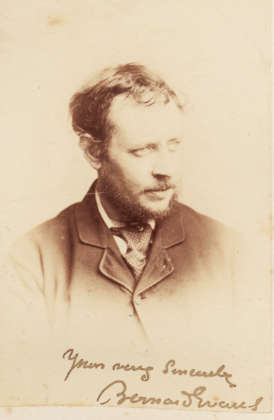Bolton Abbey from the Scar
|
Research Anne Matthews
|
Acc No 10
Artist Bernard Walter Evans, RI, RBA
Artist dates 1843-1922
Medium watercolour
Size 67.3 x 43.2 cm (26.5 x 17 in)
Date painted unknown
Inscr: signed
No image available at present Donor gift from Ethel Higson,1890-1959
18 Myra Road, Fairhaven,
Lytham St Annes
Date donated 21 April 1947
Miss Higson also donated
Rough Seas off Calais by Alfred Herbert and
Highland Scene with Sportsmen by John H Mole

ARTIST
Bernard Walter Evans was born on 26 December 1843 at Queen Street, Wolverhampton, the second of 13 children born to Walter Swift Evans and his wife, Sophia (nee Spilsbury). His father, Walter Swift Evans, was also an artist who utilised his creative abilities in a professional capacity, working as an engraver on gold and silver, a copper plate engraver and a master church furniture maker; he was associated with Pugin in the revival of mediaeval architecture. His working life was spent in and around Birmingham. Bernard Evans studied painting in Birmingham from the age of 7 under the direction of Samuel Lines, William Wallis and Edward Watson. He married Mary Ann Eliza Hollyer at St Luke's, Kentish Town in London on 2 August 1870. His wife was the daughter of Samuel and Mary Ann Eliza Hollyer; her father was an engraver, her brother, Frederick Hollyer, was a pioneer in the use of photography for reproducing works of art. Evans was a prolific painter of landscapes, in both oil and watercolour, most frequently depicting scenes in the Midlands, Yorkshire and North Wales, where he became one of the 'first thirty one' founder members of the Royal Cambrian Academy in 1882. He exhibited numerous times throughout the British Isles and abroad; his first works were exhibited in 1864 at the Royal Birmingham Society of Artists. From 1870 he exhibited at the Royal Academy on 13 occasions and 68 times at the Royal Society of British Artists, Suffolk Street, London. In 1880, whilst still living in London, Evans was a driving force behind the creation of the City of London Society of Artists and in 1881 he was elected a member of the Savage Club. He was also a member of the Society of Artists which met at Langham Chambers, where groups of artists produced the popular 'Langham Club' sketches. The Evans moved to Harrogate in the late 1880s and continued to live at 20 Park Parade until about 1911, although they spent several winters during the late 1890s on the French Riviera; paintings of Cannes and the surrounding area can be seen online. Bernard Evans died on 26 February 1922 in London. An entry in the Times for Tuesday 28 February 1922 reads: EVANS - Sunday, the 26th Feb., passed peacefully away, at the home of his niece. BERNARD WALTER EVANS, R.I. aged 79. Funeral at Harrogate, Thursday. His obituary appeared in the Harrogate Advertiser on Saturday 4 March 1922. He was buried with his wife, who had died in 1902. On a similar theme Evans also painted Fountains Abbey, Byland Abbey and Whitby Abbey. The latter belongs to the Royal Collection Trust, who note that it was possibly part of the Royal Cambrian Academy of Art jubilee gift to Queen Victoria,1887. Several of Bernard's siblings were also artists, or part of the art world, during the late 1800s and early 1900s: Edmund William Evans (1848-1908); Francis Michael Evans (1858-1937); Helen Mary Evans (1859-1947); Wilfred Godric Evans (1860-1912) Note: An entry in 'Who's Who' -1914 stated that Bernard Evans was a cousin of the author George Eliot (Mary Ann Evans 1819-1881) PAINTING For several years this painting has been identified as Bolton Abbey from the Soay. However, further research in 2022 questioned the whereabouts of the 'Soay' and after contacting Peter Evans, a relative of Bernard Evans, ([email protected]) some light has been shed on various possibilities as to what the correct title might be. He writes About 25 years ago I was able to inspect some documentation given to the Mercer Art Gallery in Harrogate by someone from another branch of our family. This included notebooks with lists of paintings, records of sales, travelogues etc. I transcribed the handwritten details into spreadsheets and have located two pictures titled "Bolton Abbey from the Scar". Given the difficulty of deciphering 19th Century handwriting I think 'Scar' could easily be mistaken for 'Soay'. One picture was painted in late 1886 and is noted as 'long' , the other was probably painted in 1892. Both were sold, one to a Mr Gunn, the other to Thomas Richardson. They were probably dealers. There are two other pictures listed during times Bernard was painting at Bolton Abbey that include the word Scar in the title. One called "Bolton Abbey from the Scar Above Skippers Wheel" and another called "Scar Fall". This latter information is of particular interest as in his 2001 Catalogue of the Collection, Stephen Sartin of the Lancashire Museum Service includes the following in the entry for Bernard's painting: "Notes: The scene represents a view of Bolton Abbey from the Soay above the Skippers Wheel". On this point Peter adds Of course, the Scar mentioned in Bernard's titling might mean a place above the Skippers Wheel in every case. If it is the picture titled "Bolton Abbey from the Scar above the Skippers Wheel" then this was sold to another dealer, Gilbert Moss. Given the above information, bearing in mind that Sartin's note was not included as part of the title, the painting has now been retitled Bolton Abbey from the Scar. |
REFERENCES
http://evansartists.co.uk/BWE.html www.rcaconwy.org/pastmembers The Times, 28 February 1922 Harrogate Advertiser, 4 March 1922 Wood,Christopher, The Dictionary of Victorian Painters, 2nd ed., Woodbridge, 1978 mutualart.com |
